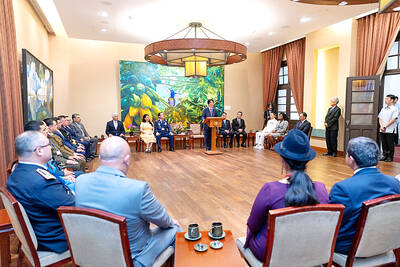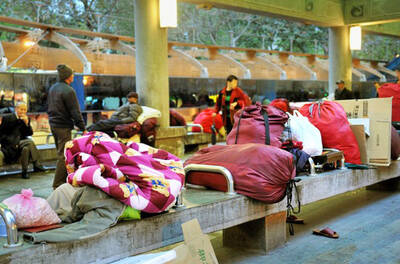Chinese Nationalist Party (KMT) Legislator Su Chi (
Su said he invented the term in order to break the cross-strait deadlock and alleviate tension.
"[Then president] Lee Teng-hui (
Su made the remarks yesterday in response to Lee who, during a Taiwan Solidarity Union seminar on Monday, said that the so-called "1992 consensus" was a fiction.
"Little monkey boy's trying to make up history," Lee said of Su, daring him to respond on the matter.
When asked by reporters for a response yesterday, Su said he did invent the term, which was meant to encourage observers to think that "each side has its own interpretation on the meaning of `one China.'"
The term "1992 consensus" is controversial. The KMT has insisted on the existence of a "consensus" between Taiwan and China during a meeting in Hong Kong in November 1992 that both sides should adhere to the "one China" principle.
Since the term appeared, however, the DPP government has insisted that no such consensus existed.
Stating that "no consensus" was reached on the definition of "one China" during the 1992 meeting, President Chen Shui-bian (
Su said he made up the term "1992 consensus" as a replacement for the expression "each side with its own interpretation" in order to benefit cross-strait development.
"The wording `each side with its own interpretation' of the `one China' principle" had been used from 1992 to 2000. But China didn't like the `each side with its own interpretation' part and the DPP government didn't like the part that said `one China,'" Su said.
"On account of these differences and the fact they could have led to more cross-strait tension after the DPP took power, I suggested the new term as a common point that was acceptable to both sides so that Taiwan and China could keep up cross-strait exchanges," he said.
Su said he initially thought the term could contribute to a resumption of cross-strait negotiations and did not think that it would be unacceptable to the DPP government.

Taiwan’s Liu Ming-i, right, who also goes by the name Ray Liu, poses with a Chinese Taipei flag after winning the gold medal in the men’s physique 170cm competition at the International Fitness and Bodybuilding Federation Asian Championship in Ajman, United Arab Emirates, yesterday.

Costa Rica sent a group of intelligence officials to Taiwan for a short-term training program, the first time the Central American country has done so since the countries ended official diplomatic relations in 2007, a Costa Rican media outlet reported last week. Five officials from the Costa Rican Directorate of Intelligence and Security last month spent 23 days in Taipei undergoing a series of training sessions focused on national security, La Nacion reported on Friday, quoting unnamed sources. The Costa Rican government has not confirmed the report. The Chinese embassy in Costa Rica protested the news, saying in a statement issued the same

A year-long renovation of Taipei’s Bangka Park (艋舺公園) began yesterday, as city workers fenced off the site and cleared out belongings left by homeless residents who had been living there. Despite protests from displaced residents, a city official defended the government’s relocation efforts, saying transitional housing has been offered. The renovation of the park in Taipei’s Wanhua District (萬華), near Longshan Temple (龍山寺), began at 9am yesterday, as about 20 homeless people packed their belongings and left after being asked to move by city personnel. Among them was a 90-year-old woman surnamed Wang (王), who last week said that she had no plans

TO BE APPEALED: The environment ministry said coal reduction goals had to be reached within two months, which was against the principle of legitimate expectation The Taipei High Administrative Court on Thursday ruled in favor of the Taichung Environmental Protection Bureau in its administrative litigation against the Ministry of Environment for the rescission of a NT$18 million fine (US$609,570) imposed by the bureau on the Taichung Power Plant in 2019 for alleged excess coal power generation. The bureau in November 2019 revised what it said was a “slip of the pen” in the text of the operating permit granted to the plant — which is run by Taiwan Power Co (Taipower) — in October 2017. The permit originally read: “reduce coal use by 40 percent from Jan.